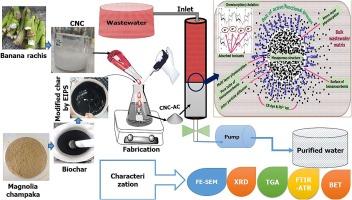Fabrication of CNC-AC bionanosorbents from the residual mass of Magnolia champaca l. Bark after methanol extraction for wastewater treatment: Continuous column adsorption study
Q1 Environmental Science
Environmental Nanotechnology, Monitoring and Management
Pub Date : 2024-10-18
DOI:10.1016/j.enmm.2024.101015
引用次数: 0
Abstract
In this current study, a new class of multifunctional biobased ecofriendly nanosorbents namely crystalline nanocellulose-activated char (CNC-AC) nanosorbents were fabricated by employing a much more innovative and beneficial solvent evaporation induced phase separation (EIPS) technique. While the crystalline nanocellulose (CNC) were extracted from a very much new, innovative, and beneficial agrowaste source namely banana tree (M. oranta) rachis fibers by conducting a series of chemical treatments like scouring, alkali treatment, bleaching, and acid hydrolysis reactions. Additionally, the biochar were synthesized from the residual mass of Magnolia champaca L. barks after methanol extraction and functionalized by 30 % H3PO4 to improve their overall properties. Besides these the fixed-bed continuous column adsorption study were carried out by optimizing the various influential factors such as preliminary concentration and flow rates of the inlet wastewater solution, along with the nanosorbent bed heights into the applied column. For better understanding the overall physicochemical, thermomechanical, and morphostructural behavior of the newly fabricated polyfunctional CNC-AC bionanosorbents the samples were characterized by conducting FTIR-ATR, FESEM, BET, XRD, TGA analysis. Meanwhile the treated and nontreated water specimens were examined by conducting AAS and UV–vis-NIR techniques. The obtained results recommended that the newly produced CNC-AC nanosorbents have contained a quite number of active edges/binding sites along with substantial sp. surface area (around 316.95 m2/g). Additionally, they possessed a crystallinity index about 59.98 ± 0.027 %, greater thermal steadiness up to 600 °C, and outstanding 2D honeycomb-like mesoporous peripheral surface microstructure with a promising spherical shapes and smaller size nearly 5–10 nm. The highest removal capacity were found at 538.91 mg/g and 455.70 mg/g for Pb2+ and CR respectively. Additionally, for better understanding the experimental breakthrough curves (BTC) were evaluated by several well established column models while the maximum R2 value was found around 0.999 for the Thomas model and reduced chi squire (χ2) value was around 0.0001.

利用木兰树皮经甲醇提取后的残渣制备用于废水处理的 CNC-AC 仿生吸附剂:连续柱吸附研究
在本研究中,通过采用更具创新性、更有益的溶剂蒸发诱导相分离(EIPS)技术,制造出了一类新型多功能生物基生态友好型纳米吸附剂,即结晶纳米纤维素活性炭(CNC-AC)纳米吸附剂。结晶纳米纤维素(CNC)是从一种非常新颖、创新和有益的农业废弃物来源,即香蕉树(M. oranta)的树枝纤维中提取出来的,通过一系列化学处理,如冲洗、碱处理、漂白和酸水解反应。此外,还利用木兰树皮经甲醇提取后的残渣合成了生物炭,并用 30% 的 H3PO4 进行了功能化处理,以改善生物炭的整体性能。此外,还通过优化各种影响因素,如废水入口溶液的初步浓度和流速,以及纳米吸附剂在应用柱中的床层高度,进行了固定床连续柱吸附研究。为了更好地了解新制备的多功能 CNC-AC 仿生吸附剂的整体物理化学、热力学和形态结构行为,对样品进行了傅立叶变换红外-原子吸收光谱(FTIR-ATR)、有限元电子显微镜(FESEM)、BET、XRD 和热重分析。同时,通过 AAS 和 UV-vis-NIR 技术对处理过和未处理过的水试样进行了检测。结果表明,新制备的 CNC-AC 纳米吸附剂含有相当多的活性边缘/结合位点以及相当大的比表面积(约 316.95 m2/g)。此外,它们的结晶度指数约为 59.98 ± 0.027 %,热稳定性高达 600 °C,二维蜂窝状介孔外围表面微观结构出色,具有良好的球形和较小的尺寸(近 5-10 nm)。对 Pb2+ 和 CR 的去除率分别为 538.91 mg/g 和 455.70 mg/g。此外,为了更好地理解实验中的突破曲线(BTC),我们采用了几种成熟的色谱柱模型对其进行了评估,结果发现托马斯模型的最大 R2 值约为 0.999,而降低的奇平方(χ2)值约为 0.0001。
本文章由计算机程序翻译,如有差异,请以英文原文为准。
求助全文
约1分钟内获得全文
求助全文
来源期刊

Environmental Nanotechnology, Monitoring and Management
Environmental Science-Water Science and Technology
CiteScore
13.00
自引率
0.00%
发文量
132
审稿时长
48 days
期刊介绍:
Environmental Nanotechnology, Monitoring and Management is a journal devoted to the publication of peer reviewed original research on environmental nanotechnologies, monitoring studies and management for water, soil , waste and human health samples. Critical review articles, short communications and scientific policy briefs are also welcome. The journal will include all environmental matrices except air. Nanomaterials were suggested as efficient cost-effective and environmental friendly alternative to existing treatment materials, from the standpoints of both resource conservation and environmental remediation. The journal aims to receive papers in the field of nanotechnology covering; Developments of new nanosorbents for: •Groundwater, drinking water and wastewater treatment •Remediation of contaminated sites •Assessment of novel nanotechnologies including sustainability and life cycle implications Monitoring and Management papers should cover the fields of: •Novel analytical methods applied to environmental and health samples •Fate and transport of pollutants in the environment •Case studies covering environmental monitoring and public health •Water and soil prevention and legislation •Industrial and hazardous waste- legislation, characterisation, management practices, minimization, treatment and disposal •Environmental management and remediation
 求助内容:
求助内容: 应助结果提醒方式:
应助结果提醒方式:


